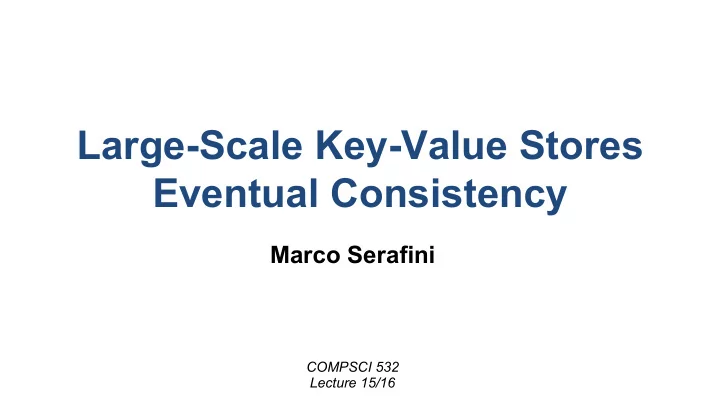

Large-Scale Key-Value Stores Eventual Consistency Marco Serafini COMPSCI 532 Lecture 15/16
Consistent Hashing 2
Consistent Hashing • Each node has a membership set M • When a node needs to access a key • It hashes the IDs of the nodes in M to a ring (mod n) • It hashes the key to the same ring (mod n) • Access goes to the next “successor” node in ring 6 1 0 nodes successor(1) = 1 1 7 In this example: successor(2) = 3 6 2 • n = 8 successor(6) = 0 • Hash function is identity for simplicity 5 3 4 3 3 2
Membership Changes • Node joins: take <k,v> pairs from successor • Node leaves: give <k,v> pairs to successor • Local changes, no global reconfiguration à good for churn 6 1 0 1 successor(1) = 1 7 successor(2) = 3 6 2 successor(6) = 0 5 3 4 2 4 4
Theoretical Results T HEOREM 1. For any set of nodes and keys, with high probability: 1. Each node is responsible for at most keys 2. When an node joins or leaves the network, respon- sibility for keys changes hands (and only to or from the joining or leaving node). • Q: What do these results tell us? • 𝜗 is arbitrarily small with 𝑃(log 𝑂) virtual nodes • Virtual nodes: multiple keys associated to the same physical node 5 5
Goals of Key-Value Stores • Export simple API • put(key, value) • get(key) • Simpler and faster than a DBMS • Less complexity, faster execution • Varied forms of consistency • Typically no support for transactions (multi-key) • Sometimes even updates to the same key are not consistent 7 7
NoSQL • Key-value stores are a typical “NoSQL” system • Properties of NoSQL • Do not require relational schema • Do not use SQL • Weak consistency 8 8
CAP: Three Properties • Consider a distributed data store for key-value pairs • Data is replicated for fault tolerance and latency • Three properties are desirable • C onsistency: system behaves as if non-replicated • A vailability: every client request is served • P artition tolerance: system can withstand network partitions 9 9
CAP “Theorem” • C, A, P: pick two • Examples • A+C: Strongly consistent system, no P • A+P: Weakly consistent system, no C • C+P: Trivial (no A required, system does nothing) • DBMS are typically A+C systems • Replication is good for fault tolerance, bad for latency • NoSQL stores are typically A+P • Replication is good for latency, bad for consistency 10 10
Eventual Consistency • Each storage node commits locally • Commits are pushed to other nodes asynchronously • Conflicts are merged with deterministic criteria 11 11
Dynamo • Large scale key-value store • Partitioned, fault tolerant • Strict Service-Level Agreement (SLA) • Upper bound on 99.9% percentile low latency • This is called tail latency 12 12
Replication and Eventual Consistency • Each key is replicated in a preference list of nodes • Eventually consistent • Updates go to first W healthy nodes in preference list • Read and write quorums might not intersect • Later reconciliation in presence of inconsistency • If a node in preference list is not reachable, skip and try to recontact later (hinted handoff) 13 13
Quorums • Sequential consistency: W+R > N • Weak consistency: W+R<=N • Q: How to set W and R to achieve persistency with f crashes AND weak consistency? 14 14
Versioning: Vector Clocks • One entry per node • Node increments its entry when updates • v 1 > v 2 if every entry of v 1 is >= than the one of v 2 and at least one is > • If two vectors cannot be ordered, conflict Figure 3: Version evolution of an object over time. 15 15
Recommend
More recommend